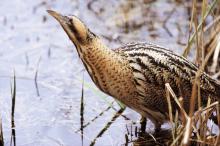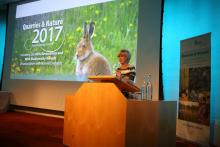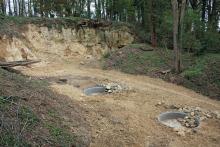
Long term partnering between Tarmac and a local wildlife trust to plan the restoration of lound gravel pits is believed to be the key to the success of the project.
Success in terms of quarry restoration goes far beyond returning the site to a safe state these days and is defined more in terms of biodiversity, stakeholder partnership and community involvement. When it came to returning Tarmac's Lound gravel pits in Nottinghamshire, UK back to nature, the focus was very much on the more modern approach.
Tarmac's Bellmoor and Lound estate is situated in the valley of the River Idle, north of Retford, Nottinghamshire and has been worked for high-quality alluvial sands and gravels since the mid 1940s. The estate has been in Tarmac's ownership since 1981.
Historically, Bellmoor quarry, to the south of the estate, produced 350,000tonnes of sand and gravel per annum. Extraction ceased in 2005 and the site is now home to the Central regional office of Tarmac. Lound quarry, to the north of Bellmoor has typically produced a larger output of approximately 500,000tonnes of sand and gravel per year.
Since its opening in 1940, it is estimated that 30million tonnes of sand and gravel have been extracted and sold from the quarries to serve local construction markets. The quarry is still operational, but work is winding down and Tarmac will cease extraction from Lound later this year. Tarmac's restoration and aftercare plans are on schedule and the company anticipates that the site will be fully restored by the end of 2012.
Back to nature
Originally required to be restored to agricultural land, the average depth of sand and gravel extracted at the Bellmoor and Lound quarries was 2 to 3m. In order to fill the resulting voids to original levels and allow agricultural restoration, Pulverised Fuel Ash (PFA) from nearby Cottam Power Station was pumped, by
In the early 1990's Powergen ceased PFA infilling and this meant that full agricultural restoration could not take place and large areas were left as water-filled voids. Over time this land re-generated naturally and became a haven for wildlife and in April 2002, 316ha of Bellmoor and Lound quarries were designated as SSSI, due largely to its assemblages of breeding, wintering and passage birds.
Working with local partners to manage the restoration in line with local and environmental needs has been key to its success as Tarmac estates manager Neil Beards explains, "We worked very closely with NWT to prepare detailed restoration proposals for the land and water within the SSSI. We then put these to
"We frequently engage with NWT and all of our restoration works within the SSSI are approved and monitored by them at regular meetings and with on-site supervisions to agree when and how the final landforms are achieved.
"We recognised that it was important to engage with local partners and bodies early on in the restoration planning process to ensure that with careful management, both during and after extraction, the impact of quarrying on the surrounding area is minimised and that once decommissioned, the quarry site becomes a habitat for interesting and diverse wildlife and an asset to the local community," said Beards.
As part of the aftercare of the Lound/ Bellmoor estate Tarmac has agreed to donate all of its land within the SSSI to NWT to ensure that the area is protected and nurtured for the future.
Learning centre
The idea of a joint NWT/ North Nottinghamshire College education centre and visitor facility was developed following a presentation to the Bassetlaw Local Strategic Partnership, when the local tertiary college identified that its desire to support a rural population with training close to the centre of population at Retford could form the basis of a project adjacent to the extensive SSSI.
Very quickly the synergies of the college using the site during academic term time and the community and visitors using the site at weekends and in the holidays became apparent. The building was funded via the European Regional Development Fund and the Alliance SSP and Tarmac transferred the land to the Nottinghamshire Wildlife Trust in 2007.
Recent work at the site has seen a new viewing screen installed, some 4km of fencing erected to increase the grazing of the site and approximately four hectares of scrub cleared to improve the openness of the site for wetland birds. NWT has also achieved a further two hectares of scrub clearance, brought nine islands under management, created a 2.5km path around the Idle Valley Rural Learning Centre with recycled aggregate from Tarmac, brought 8ha of grassland under management and extended grazing to a further 30 hectares of land. Finally, 200m of hedgerow have been laid, a new viewing platform installed and a 150m willow arch created.
Historically over 170 different bird species have been sighted at Lound counted with the generous help of volunteers at the Lound Bird Club. In 2004 and 2008, the quarry came first in its category in the British Trust for Ornithology-British Business Bird Challenge.
Future "We will continue to work in partnership with NWT until the aftercare period is over and both NE and NCC confirm that the restoration and aftercare of the SSSI are complete to their satisfaction. At this point, we look forward to donating the remaining SSSI land to NWT," said Beards.
NWT head of estate management Charles Langtree added, "Tarmac and the Sutton and Lound Gravel Pits site is enabling us to achieve many of our ambitions for the north of Nottinghamshire. It is a very special site worthy of the SSSI status and the success it has in bird competitions.
"It is also important to consider how the other priorities such as recreation and commercial interests of land owners have been resolved in the peripheral parts of the complex. I am certainly keen to see the site develop and to continue to work with Tarmac to maximise the potential of this wonderful ex gravel pit complex." Beyond the current limits of the SSSI, modifications to the existing approved Restoration Plan for the final extraction area at Lound quarry will see some 20ha of void being restored to a wetland scrape landform.
Historically, prior to intensive farming and river management, this area, adjacent to the River Idle, would have been seasonally flooded with marshy shallow ponds and hollows. This provided a diverse habitat for amphibians, insects, ground nesting and wading birds which in modern times was lost.
Tarmac's proposed modifications will hopefully re-create a natural preagricultural landscape.
It is anticipated that this site will become a magnet for migrating and nesting birds which will further improve what is a regionally important area for wildlife.














